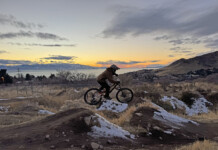By Cari Junge
In the Sport of Triathlon:
What do you call the athlete first out of the water? Correct, a high-level ‘swimmer’
What do you call the athlete with the fastest bike split? Yes, a high-level ‘cyclist’
What do you call the athlete with the fastest run time? Correct again, a high-level ‘runner’
What do you call the athlete first to cross the finish line? Not just the winner, but . . . a high-level ‘tri-athlete’.
The athlete with the fastest split in one given leg of a multisport race is no doubt dialed sport-specifically. He has mastered performance in that leg of the race, proving to be fastest in that environment, regardless of what he did before or after.
The athlete that crosses the finish line first has maximized swim-to-bike-to-run economy, transitions, biomechanics, pacing, nutrition, overall speed and so much more. This athlete is a master of multisport racing (in this case of three sports), and the winning triathlete.
Truly, we are all triathletes by participating in the sport that includes swim-bike-run legs before the finish, whether we perform recreationally, competitively or professionally. The above analysis was resolved from conversations with a good friend years ago during our post-race recaps, and personal jab sessions. We would reflect on our individual performances and note the field that won on different levels, recognizing there might be worth in clarifying performance titles when racing multisport.
There are many faces of triathlon. For point sake, there are those with pure passion for the experience, the camaraderie and/or healthy structure as they strive for a safe and comfortable pace. There are those with power and precision in one given sport, while the other leg(s) of the race appear to hinder them overall. And then there’s the multisport master who can pull it all together with strong overall results.
Across the past few months, we have explored and resolved tips for dealing with the impact of Mother Nature on training and racing. We realized the importance of evaluating the facts from race day, especially when it wasn’t our best, and take time to step back and fine tune before our next big goal event. The message this month explains benefits of dedicating what I call Mind.Body.Sport time to nurture single-sport mastery as a multisport athlete. And in doing so, it’s important not to lose sight of your title and performance guidelines as a triathlete- even if those around you knock your worth.
Some say the sport of triathlon was birthed from bad blood- or friendly competition- between the swimmer, the cyclist, and the runner. The Hawaiian Mid-Pacific Road Runners and Waikiki Swim Club would debate back in the mid 1970’s over who was fitter, the swimmer or the runner. And when Eddy Merckx, the Belgian cyclist, was named as having the highest recorded maximum oxygen uptake of any athlete measured, the cycling community joined the field. The battles began in 1978 when a swim to bike to run ‘triathlon’ conceived in Mission Bay in the early ‘70s was expanded upon for the first long-distance triathlon on the Big Island of Hawaii.
Today you might breathe some thick air on the road when a cyclist and a triathlete are within bike length’s distance. The very scientific data out there shows that cyclists tout the triathlete as having poor bike handling skills and therefore dangerous to ride with, let alone in a pack. We are often reminded of the extravagant hoarding of stuff on the bike- secret stashes, creative ways to use electrical tape, or personal diaries of photos and mantras visible for motivation. Of course the lightest and most expensive componentry out there compensates for weight added by the frills.
If I’ve made enemies of a few of you triathletes for stirring the pot, please know that I’ve competed in triathlon for over 20 years. I’ve fielded many levels of banter, and I’ve created rituals to initiate it, therefore finding yet again great pleasure from the sport. There was a period of time during my triathlon career when I did some bike racing, and I was represented by a local bike shop. As many offer, I was able to bring my bike in for regular tuning and maintenance which was always a good laugh for the techies servicing ‘the triathlete who’s a cyclist wanna-be’. The first time I brought my time trial bike, near kid size given my stature, ‘Joe’ (we will call him) picked it up to mount on a bike stand and belted a ‘FU^&%*&^%’ that sent most customers running. Oops, forgot to tell him about my wad of chamois cream stashed under the saddle just in case, and at the time this was post-race flavor. From that point on, my creative expressions became gifts for triathletes to become more efficient and authentic, and for Joe to get more pissed off.
Getting back to the message for today, let’s focus on the benefits of a triathlete putting mind and body into the sport of cycling for performance gains as a triathlete. I believe in order to de-sensitize from the jabs and knocks of the sport-specific masters, we need to understand the root of the criticism, nurture those areas requiring special attention, embrace our differences, and then take on the challenges.
TOP FIVE REASONS WHY ‘RESEARCH SHOWS’ CYCLISTS TORMENT US
1. Who gets a medal for simply crossing the finish line at a bike race?
2. Between support vehicles and rolling buffets, no wonder why And the support along the way is nearly unheard of, let alone those who couldn’t fix a flat if their finish depended on it.
3. Tape is for real needs, not to attach chapstick to handlebars or gel packs to the headset.
4. Learn how to drink and ride, corner the round-a-bouts, cue road etiquette, signal a stop- basic road etiquette, duh?!
5. There’s one thing that doesn’t belong in a group ride- a triathlete with aerobars!
TOP MIND.BODY.SPORT TIPS FOR STRENGTHENING CYCLING SKILLS AS A TRIATHLON
BE A SPECTATOR
Get your head in the game and prioritize watching the best locally and internationally. Ironman races on tv are a great opportunity for the sport and for us athletes to see the best cruise through transitions. When it comes to mastering cycling sport-specifically for multisport, watch a full stage (or 20 for that matter) of the Tour de France. Watch pedaling technique, bike handling on breakaways, and tactics not allowed in triathlon as a sport. Many times, that’s how we learn best, by studying what we cannot do.
Go to a stage or 5 of the Tour of Utah where you can see firsthand real action. Hyper focus on the racers’ efficiencies and economies of riding the bike on your training ground. Watch body signals, muscle recruitment to achieve certain tactics, and facial expressions talking. Catch the time trial given that’s as close as a bike race will get to your triathlon cycling.
TRAIN ECONOMICALLY
Apply the specificity principle to your cycling-specific training whenever possible. If you dabble with cycling group rides, events, or races (which is not necessarily encouraged for the triathlete), stay focused on your tri-goals. Again, time trialing is a great simulation for triathlon. Take advantage of fixed distance non-drafting, maximal aerobic capacity, and speed in the aerobar position. Adding a short transition run could make sense for your training plan at times.
Trouble may strike when you dabble in criteriums or road races. These environments unlike triathlon have periods where you can sit in- pace lines, drafting, etc… Crits drive time in the drops where many of us don’t even know where they are. The finish comes down to explosive efforts at maximal output (if your bike handling skills are weak, watch out!). Triathlon does not. There can be a time and a place if these activities spell fun for you, but to race triathlon optimally, you need to train as economically as you perform triathlon. Otherwise, can you spell o-v-e-r-t-r-a-i-n-i-n-g?
CONTROL IT, DON’T CRASH IT
Dedicate time to controlling your equipment, and not letting it control you. The bike demands a safety-first mentality which requires practice time for the body to perform safety techniques innately. It takes 10,000 repetitions to instill a habit so to master hydrating on the bike; you’ve got to practice it in a range of environments, with others around and not. Simulate handling tactics when riding through a feed zone, if you participate in events with water stations on the bike. And most critically, learn the rules of the road if you haven’t yet- you certainly can’t drive without a license, and perhaps someday we’d all be better off if there was a requirement for riding.
CLAIM YOUR TITLE
Claim your title with pride and define what it means ‘to win’. With these in mind, establish your goal with triathlon as a generalist or a specialist. Your generalist’s cap supports your abilities across a range of different things, being generally good at most. Your specialist’s lid fits the one area, or a few, where you shine. Both hats can lead to a win, whether my definition or yours.
Cari Junge has over 20 years racing, coaching and teaching experience in the endurance sport industry. She is a certified USATriathlon & USACycling Level II Coach, an 8x ironman athlete, and is currently the Nutrition & Therapy Director for ‘Utah Sports and Wellness’. For more information, see www.utahsportsandwellness.com .






